Analyzing Social Media in Workplace Communication: COMM2003 DT331/2
VerifiedAdded on 2022/09/09
|7
|2186
|14
Essay
AI Summary
This essay examines the impact of social media on workplace communication, discussing its role in enhancing stakeholder interaction and employee engagement while also addressing the challenges it presents. The essay begins by exploring the advantages of social media, such as its ability to facilitate real-time communication, digital marketing, and cost-effective advertising. It then delves into the challenges, including distractions, potential security breaches, and the risks associated with employee misuse. The analysis considers the impact of social media on various aspects of the workplace, including team collaboration, information sharing, and external communication, and provides recommendations for managing these challenges. The essay incorporates academic references to support its arguments and offers a balanced perspective on the benefits and drawbacks of social media in the professional environment.
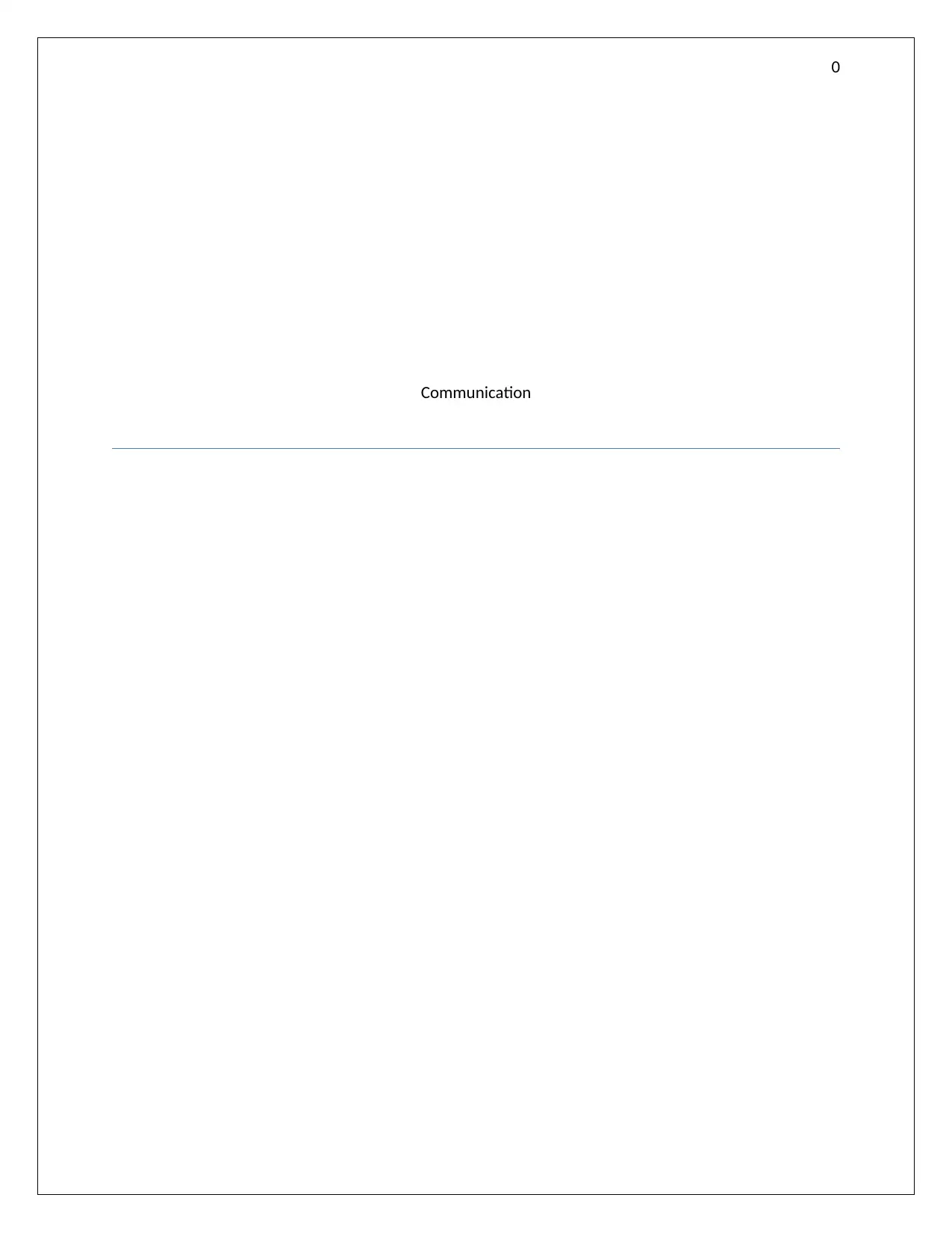
0
Communication
Communication
Paraphrase This Document
Need a fresh take? Get an instant paraphrase of this document with our AI Paraphraser
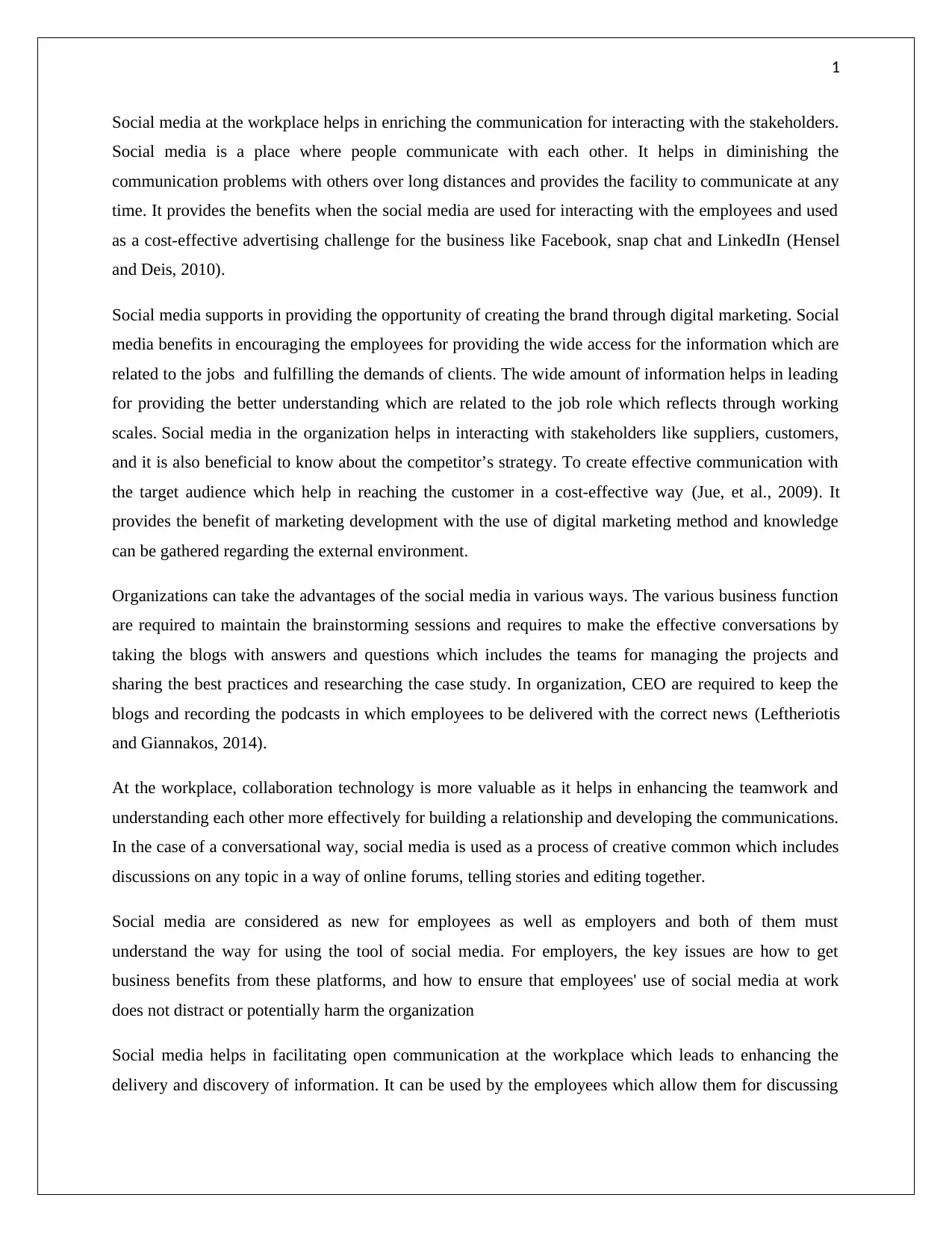
1
Social media at the workplace helps in enriching the communication for interacting with the stakeholders.
Social media is a place where people communicate with each other. It helps in diminishing the
communication problems with others over long distances and provides the facility to communicate at any
time. It provides the benefits when the social media are used for interacting with the employees and used
as a cost-effective advertising challenge for the business like Facebook, snap chat and LinkedIn (Hensel
and Deis, 2010).
Social media supports in providing the opportunity of creating the brand through digital marketing. Social
media benefits in encouraging the employees for providing the wide access for the information which are
related to the jobs and fulfilling the demands of clients. The wide amount of information helps in leading
for providing the better understanding which are related to the job role which reflects through working
scales. Social media in the organization helps in interacting with stakeholders like suppliers, customers,
and it is also beneficial to know about the competitor’s strategy. To create effective communication with
the target audience which help in reaching the customer in a cost-effective way (Jue, et al., 2009). It
provides the benefit of marketing development with the use of digital marketing method and knowledge
can be gathered regarding the external environment.
Organizations can take the advantages of the social media in various ways. The various business function
are required to maintain the brainstorming sessions and requires to make the effective conversations by
taking the blogs with answers and questions which includes the teams for managing the projects and
sharing the best practices and researching the case study. In organization, CEO are required to keep the
blogs and recording the podcasts in which employees to be delivered with the correct news (Leftheriotis
and Giannakos, 2014).
At the workplace, collaboration technology is more valuable as it helps in enhancing the teamwork and
understanding each other more effectively for building a relationship and developing the communications.
In the case of a conversational way, social media is used as a process of creative common which includes
discussions on any topic in a way of online forums, telling stories and editing together.
Social media are considered as new for employees as well as employers and both of them must
understand the way for using the tool of social media. For employers, the key issues are how to get
business benefits from these platforms, and how to ensure that employees' use of social media at work
does not distract or potentially harm the organization
Social media helps in facilitating open communication at the workplace which leads to enhancing the
delivery and discovery of information. It can be used by the employees which allow them for discussing
Social media at the workplace helps in enriching the communication for interacting with the stakeholders.
Social media is a place where people communicate with each other. It helps in diminishing the
communication problems with others over long distances and provides the facility to communicate at any
time. It provides the benefits when the social media are used for interacting with the employees and used
as a cost-effective advertising challenge for the business like Facebook, snap chat and LinkedIn (Hensel
and Deis, 2010).
Social media supports in providing the opportunity of creating the brand through digital marketing. Social
media benefits in encouraging the employees for providing the wide access for the information which are
related to the jobs and fulfilling the demands of clients. The wide amount of information helps in leading
for providing the better understanding which are related to the job role which reflects through working
scales. Social media in the organization helps in interacting with stakeholders like suppliers, customers,
and it is also beneficial to know about the competitor’s strategy. To create effective communication with
the target audience which help in reaching the customer in a cost-effective way (Jue, et al., 2009). It
provides the benefit of marketing development with the use of digital marketing method and knowledge
can be gathered regarding the external environment.
Organizations can take the advantages of the social media in various ways. The various business function
are required to maintain the brainstorming sessions and requires to make the effective conversations by
taking the blogs with answers and questions which includes the teams for managing the projects and
sharing the best practices and researching the case study. In organization, CEO are required to keep the
blogs and recording the podcasts in which employees to be delivered with the correct news (Leftheriotis
and Giannakos, 2014).
At the workplace, collaboration technology is more valuable as it helps in enhancing the teamwork and
understanding each other more effectively for building a relationship and developing the communications.
In the case of a conversational way, social media is used as a process of creative common which includes
discussions on any topic in a way of online forums, telling stories and editing together.
Social media are considered as new for employees as well as employers and both of them must
understand the way for using the tool of social media. For employers, the key issues are how to get
business benefits from these platforms, and how to ensure that employees' use of social media at work
does not distract or potentially harm the organization
Social media helps in facilitating open communication at the workplace which leads to enhancing the
delivery and discovery of information. It can be used by the employees which allow them for discussing
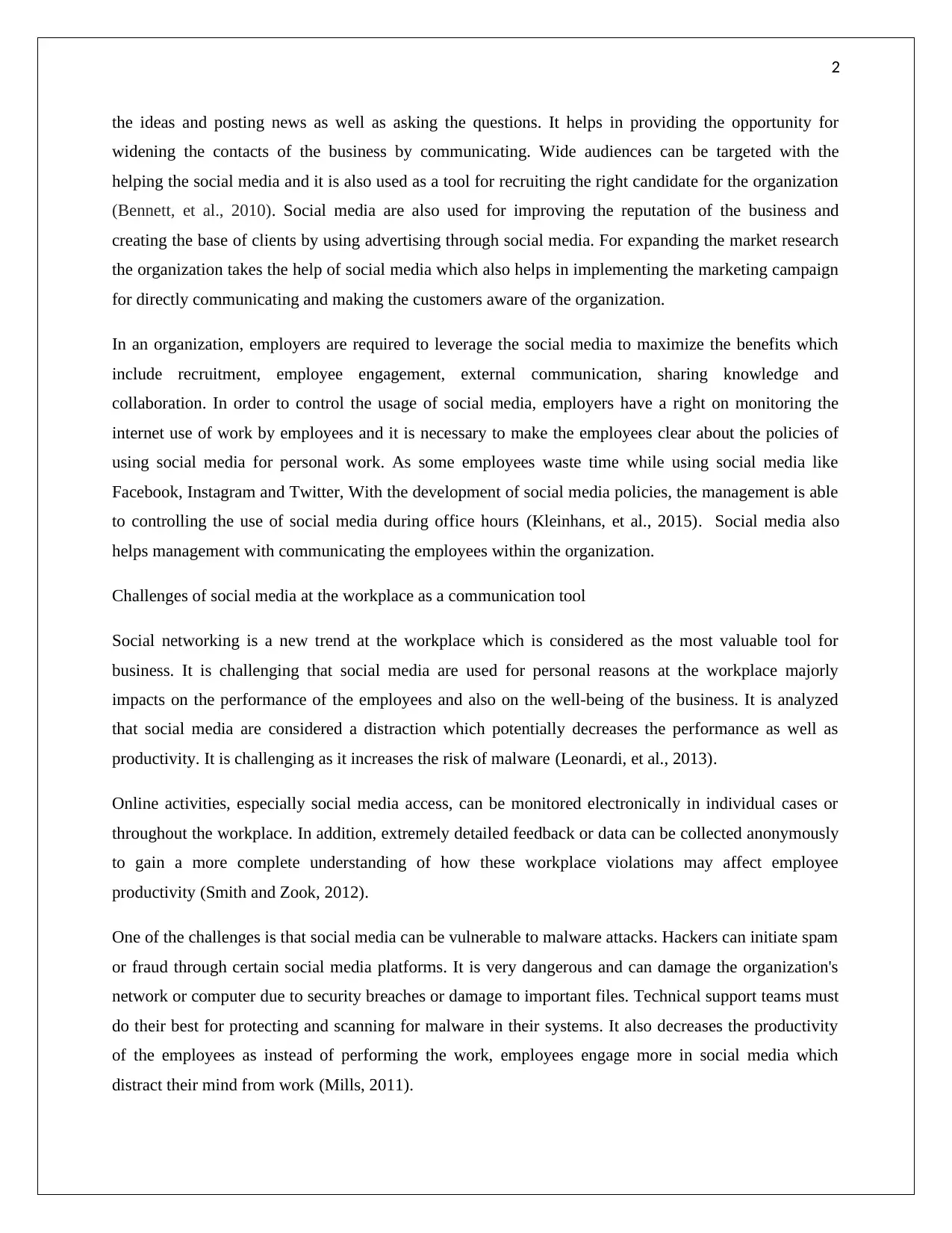
2
the ideas and posting news as well as asking the questions. It helps in providing the opportunity for
widening the contacts of the business by communicating. Wide audiences can be targeted with the
helping the social media and it is also used as a tool for recruiting the right candidate for the organization
(Bennett, et al., 2010). Social media are also used for improving the reputation of the business and
creating the base of clients by using advertising through social media. For expanding the market research
the organization takes the help of social media which also helps in implementing the marketing campaign
for directly communicating and making the customers aware of the organization.
In an organization, employers are required to leverage the social media to maximize the benefits which
include recruitment, employee engagement, external communication, sharing knowledge and
collaboration. In order to control the usage of social media, employers have a right on monitoring the
internet use of work by employees and it is necessary to make the employees clear about the policies of
using social media for personal work. As some employees waste time while using social media like
Facebook, Instagram and Twitter, With the development of social media policies, the management is able
to controlling the use of social media during office hours (Kleinhans, et al., 2015). Social media also
helps management with communicating the employees within the organization.
Challenges of social media at the workplace as a communication tool
Social networking is a new trend at the workplace which is considered as the most valuable tool for
business. It is challenging that social media are used for personal reasons at the workplace majorly
impacts on the performance of the employees and also on the well-being of the business. It is analyzed
that social media are considered a distraction which potentially decreases the performance as well as
productivity. It is challenging as it increases the risk of malware (Leonardi, et al., 2013).
Online activities, especially social media access, can be monitored electronically in individual cases or
throughout the workplace. In addition, extremely detailed feedback or data can be collected anonymously
to gain a more complete understanding of how these workplace violations may affect employee
productivity (Smith and Zook, 2012).
One of the challenges is that social media can be vulnerable to malware attacks. Hackers can initiate spam
or fraud through certain social media platforms. It is very dangerous and can damage the organization's
network or computer due to security breaches or damage to important files. Technical support teams must
do their best for protecting and scanning for malware in their systems. It also decreases the productivity
of the employees as instead of performing the work, employees engage more in social media which
distract their mind from work (Mills, 2011).
the ideas and posting news as well as asking the questions. It helps in providing the opportunity for
widening the contacts of the business by communicating. Wide audiences can be targeted with the
helping the social media and it is also used as a tool for recruiting the right candidate for the organization
(Bennett, et al., 2010). Social media are also used for improving the reputation of the business and
creating the base of clients by using advertising through social media. For expanding the market research
the organization takes the help of social media which also helps in implementing the marketing campaign
for directly communicating and making the customers aware of the organization.
In an organization, employers are required to leverage the social media to maximize the benefits which
include recruitment, employee engagement, external communication, sharing knowledge and
collaboration. In order to control the usage of social media, employers have a right on monitoring the
internet use of work by employees and it is necessary to make the employees clear about the policies of
using social media for personal work. As some employees waste time while using social media like
Facebook, Instagram and Twitter, With the development of social media policies, the management is able
to controlling the use of social media during office hours (Kleinhans, et al., 2015). Social media also
helps management with communicating the employees within the organization.
Challenges of social media at the workplace as a communication tool
Social networking is a new trend at the workplace which is considered as the most valuable tool for
business. It is challenging that social media are used for personal reasons at the workplace majorly
impacts on the performance of the employees and also on the well-being of the business. It is analyzed
that social media are considered a distraction which potentially decreases the performance as well as
productivity. It is challenging as it increases the risk of malware (Leonardi, et al., 2013).
Online activities, especially social media access, can be monitored electronically in individual cases or
throughout the workplace. In addition, extremely detailed feedback or data can be collected anonymously
to gain a more complete understanding of how these workplace violations may affect employee
productivity (Smith and Zook, 2012).
One of the challenges is that social media can be vulnerable to malware attacks. Hackers can initiate spam
or fraud through certain social media platforms. It is very dangerous and can damage the organization's
network or computer due to security breaches or damage to important files. Technical support teams must
do their best for protecting and scanning for malware in their systems. It also decreases the productivity
of the employees as instead of performing the work, employees engage more in social media which
distract their mind from work (Mills, 2011).
⊘ This is a preview!⊘
Do you want full access?
Subscribe today to unlock all pages.

Trusted by 1+ million students worldwide
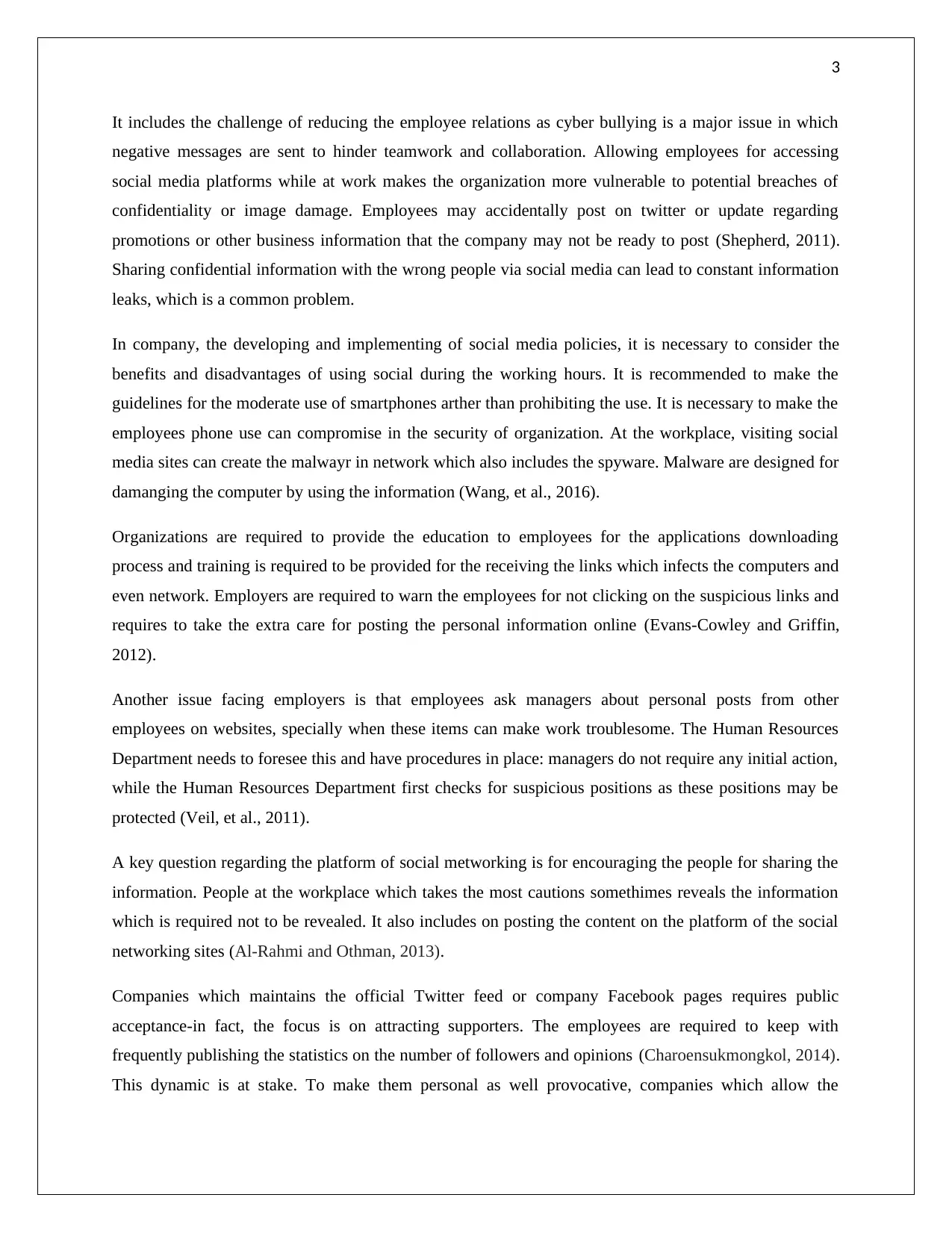
3
It includes the challenge of reducing the employee relations as cyber bullying is a major issue in which
negative messages are sent to hinder teamwork and collaboration. Allowing employees for accessing
social media platforms while at work makes the organization more vulnerable to potential breaches of
confidentiality or image damage. Employees may accidentally post on twitter or update regarding
promotions or other business information that the company may not be ready to post (Shepherd, 2011).
Sharing confidential information with the wrong people via social media can lead to constant information
leaks, which is a common problem.
In company, the developing and implementing of social media policies, it is necessary to consider the
benefits and disadvantages of using social during the working hours. It is recommended to make the
guidelines for the moderate use of smartphones arther than prohibiting the use. It is necessary to make the
employees phone use can compromise in the security of organization. At the workplace, visiting social
media sites can create the malwayr in network which also includes the spyware. Malware are designed for
damanging the computer by using the information (Wang, et al., 2016).
Organizations are required to provide the education to employees for the applications downloading
process and training is required to be provided for the receiving the links which infects the computers and
even network. Employers are required to warn the employees for not clicking on the suspicious links and
requires to take the extra care for posting the personal information online (Evans-Cowley and Griffin,
2012).
Another issue facing employers is that employees ask managers about personal posts from other
employees on websites, specially when these items can make work troublesome. The Human Resources
Department needs to foresee this and have procedures in place: managers do not require any initial action,
while the Human Resources Department first checks for suspicious positions as these positions may be
protected (Veil, et al., 2011).
A key question regarding the platform of social metworking is for encouraging the people for sharing the
information. People at the workplace which takes the most cautions somethimes reveals the information
which is required not to be revealed. It also includes on posting the content on the platform of the social
networking sites (Al-Rahmi and Othman, 2013).
Companies which maintains the official Twitter feed or company Facebook pages requires public
acceptance-in fact, the focus is on attracting supporters. The employees are required to keep with
frequently publishing the statistics on the number of followers and opinions (Charoensukmongkol, 2014).
This dynamic is at stake. To make them personal as well provocative, companies which allow the
It includes the challenge of reducing the employee relations as cyber bullying is a major issue in which
negative messages are sent to hinder teamwork and collaboration. Allowing employees for accessing
social media platforms while at work makes the organization more vulnerable to potential breaches of
confidentiality or image damage. Employees may accidentally post on twitter or update regarding
promotions or other business information that the company may not be ready to post (Shepherd, 2011).
Sharing confidential information with the wrong people via social media can lead to constant information
leaks, which is a common problem.
In company, the developing and implementing of social media policies, it is necessary to consider the
benefits and disadvantages of using social during the working hours. It is recommended to make the
guidelines for the moderate use of smartphones arther than prohibiting the use. It is necessary to make the
employees phone use can compromise in the security of organization. At the workplace, visiting social
media sites can create the malwayr in network which also includes the spyware. Malware are designed for
damanging the computer by using the information (Wang, et al., 2016).
Organizations are required to provide the education to employees for the applications downloading
process and training is required to be provided for the receiving the links which infects the computers and
even network. Employers are required to warn the employees for not clicking on the suspicious links and
requires to take the extra care for posting the personal information online (Evans-Cowley and Griffin,
2012).
Another issue facing employers is that employees ask managers about personal posts from other
employees on websites, specially when these items can make work troublesome. The Human Resources
Department needs to foresee this and have procedures in place: managers do not require any initial action,
while the Human Resources Department first checks for suspicious positions as these positions may be
protected (Veil, et al., 2011).
A key question regarding the platform of social metworking is for encouraging the people for sharing the
information. People at the workplace which takes the most cautions somethimes reveals the information
which is required not to be revealed. It also includes on posting the content on the platform of the social
networking sites (Al-Rahmi and Othman, 2013).
Companies which maintains the official Twitter feed or company Facebook pages requires public
acceptance-in fact, the focus is on attracting supporters. The employees are required to keep with
frequently publishing the statistics on the number of followers and opinions (Charoensukmongkol, 2014).
This dynamic is at stake. To make them personal as well provocative, companies which allow the
Paraphrase This Document
Need a fresh take? Get an instant paraphrase of this document with our AI Paraphraser
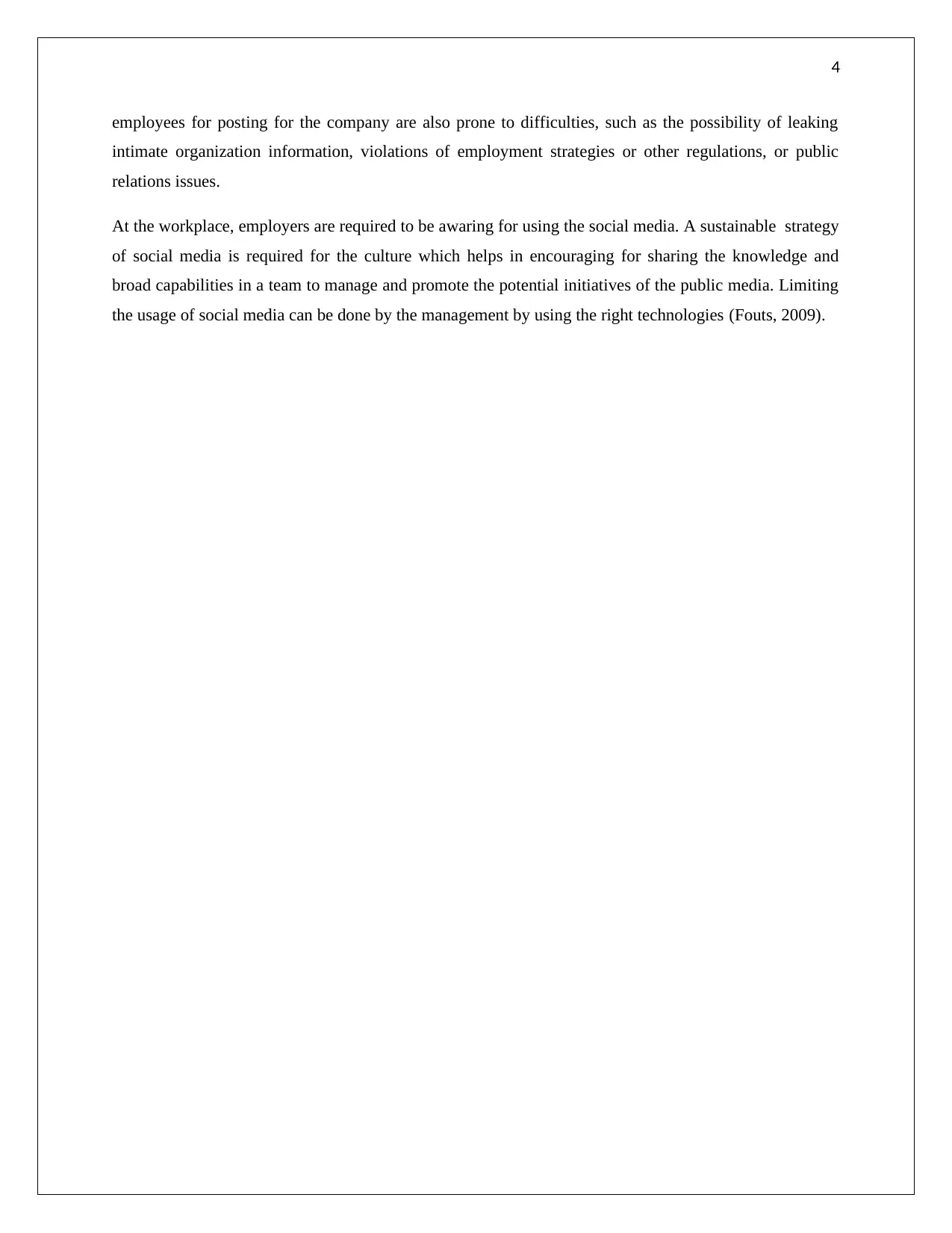
4
employees for posting for the company are also prone to difficulties, such as the possibility of leaking
intimate organization information, violations of employment strategies or other regulations, or public
relations issues.
At the workplace, employers are required to be awaring for using the social media. A sustainable strategy
of social media is required for the culture which helps in encouraging for sharing the knowledge and
broad capabilities in a team to manage and promote the potential initiatives of the public media. Limiting
the usage of social media can be done by the management by using the right technologies (Fouts, 2009).
employees for posting for the company are also prone to difficulties, such as the possibility of leaking
intimate organization information, violations of employment strategies or other regulations, or public
relations issues.
At the workplace, employers are required to be awaring for using the social media. A sustainable strategy
of social media is required for the culture which helps in encouraging for sharing the knowledge and
broad capabilities in a team to manage and promote the potential initiatives of the public media. Limiting
the usage of social media can be done by the management by using the right technologies (Fouts, 2009).
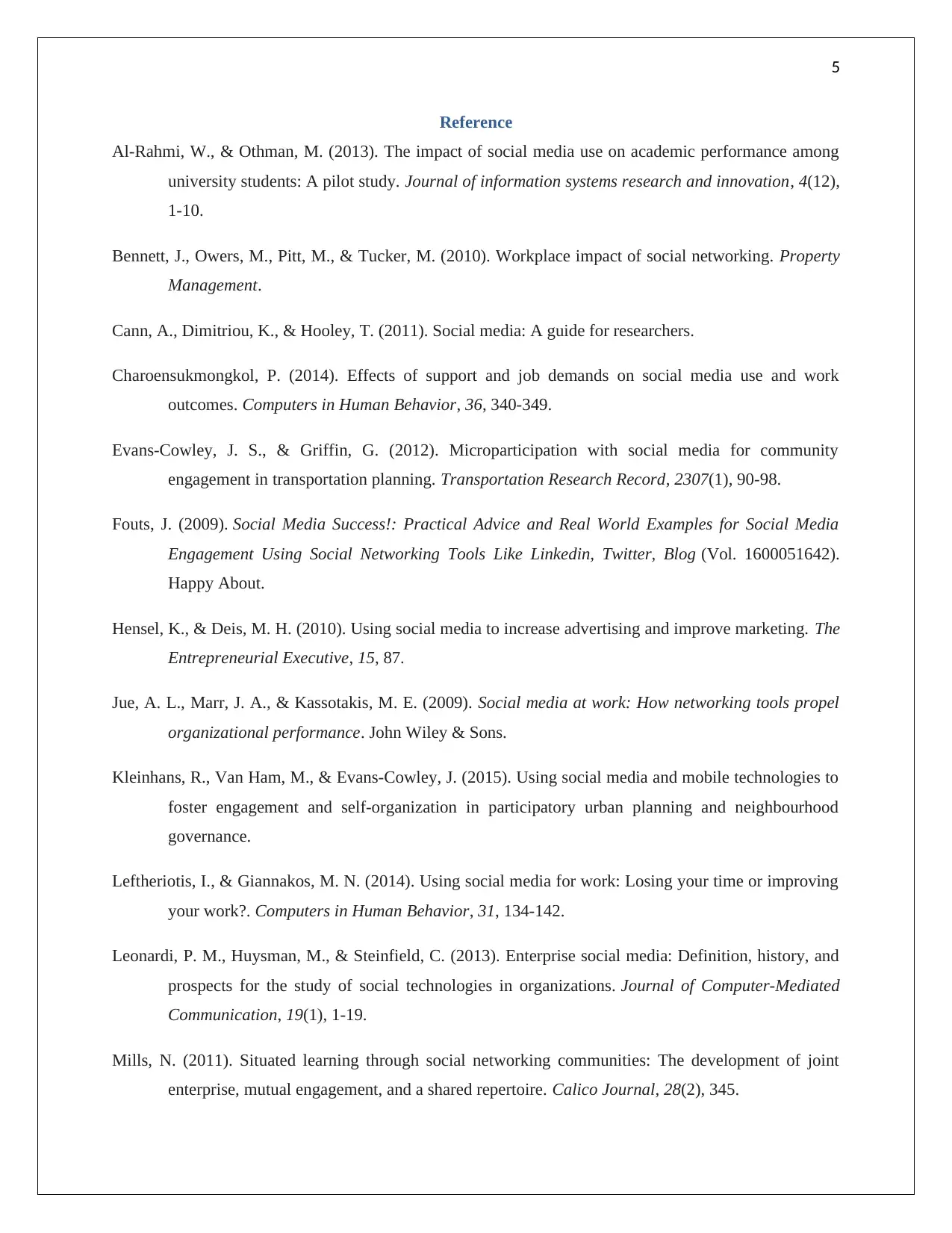
5
Reference
Al-Rahmi, W., & Othman, M. (2013). The impact of social media use on academic performance among
university students: A pilot study. Journal of information systems research and innovation, 4(12),
1-10.
Bennett, J., Owers, M., Pitt, M., & Tucker, M. (2010). Workplace impact of social networking. Property
Management.
Cann, A., Dimitriou, K., & Hooley, T. (2011). Social media: A guide for researchers.
Charoensukmongkol, P. (2014). Effects of support and job demands on social media use and work
outcomes. Computers in Human Behavior, 36, 340-349.
Evans-Cowley, J. S., & Griffin, G. (2012). Microparticipation with social media for community
engagement in transportation planning. Transportation Research Record, 2307(1), 90-98.
Fouts, J. (2009). Social Media Success!: Practical Advice and Real World Examples for Social Media
Engagement Using Social Networking Tools Like Linkedin, Twitter, Blog (Vol. 1600051642).
Happy About.
Hensel, K., & Deis, M. H. (2010). Using social media to increase advertising and improve marketing. The
Entrepreneurial Executive, 15, 87.
Jue, A. L., Marr, J. A., & Kassotakis, M. E. (2009). Social media at work: How networking tools propel
organizational performance. John Wiley & Sons.
Kleinhans, R., Van Ham, M., & Evans-Cowley, J. (2015). Using social media and mobile technologies to
foster engagement and self-organization in participatory urban planning and neighbourhood
governance.
Leftheriotis, I., & Giannakos, M. N. (2014). Using social media for work: Losing your time or improving
your work?. Computers in Human Behavior, 31, 134-142.
Leonardi, P. M., Huysman, M., & Steinfield, C. (2013). Enterprise social media: Definition, history, and
prospects for the study of social technologies in organizations. Journal of Computer-Mediated
Communication, 19(1), 1-19.
Mills, N. (2011). Situated learning through social networking communities: The development of joint
enterprise, mutual engagement, and a shared repertoire. Calico Journal, 28(2), 345.
Reference
Al-Rahmi, W., & Othman, M. (2013). The impact of social media use on academic performance among
university students: A pilot study. Journal of information systems research and innovation, 4(12),
1-10.
Bennett, J., Owers, M., Pitt, M., & Tucker, M. (2010). Workplace impact of social networking. Property
Management.
Cann, A., Dimitriou, K., & Hooley, T. (2011). Social media: A guide for researchers.
Charoensukmongkol, P. (2014). Effects of support and job demands on social media use and work
outcomes. Computers in Human Behavior, 36, 340-349.
Evans-Cowley, J. S., & Griffin, G. (2012). Microparticipation with social media for community
engagement in transportation planning. Transportation Research Record, 2307(1), 90-98.
Fouts, J. (2009). Social Media Success!: Practical Advice and Real World Examples for Social Media
Engagement Using Social Networking Tools Like Linkedin, Twitter, Blog (Vol. 1600051642).
Happy About.
Hensel, K., & Deis, M. H. (2010). Using social media to increase advertising and improve marketing. The
Entrepreneurial Executive, 15, 87.
Jue, A. L., Marr, J. A., & Kassotakis, M. E. (2009). Social media at work: How networking tools propel
organizational performance. John Wiley & Sons.
Kleinhans, R., Van Ham, M., & Evans-Cowley, J. (2015). Using social media and mobile technologies to
foster engagement and self-organization in participatory urban planning and neighbourhood
governance.
Leftheriotis, I., & Giannakos, M. N. (2014). Using social media for work: Losing your time or improving
your work?. Computers in Human Behavior, 31, 134-142.
Leonardi, P. M., Huysman, M., & Steinfield, C. (2013). Enterprise social media: Definition, history, and
prospects for the study of social technologies in organizations. Journal of Computer-Mediated
Communication, 19(1), 1-19.
Mills, N. (2011). Situated learning through social networking communities: The development of joint
enterprise, mutual engagement, and a shared repertoire. Calico Journal, 28(2), 345.
⊘ This is a preview!⊘
Do you want full access?
Subscribe today to unlock all pages.

Trusted by 1+ million students worldwide
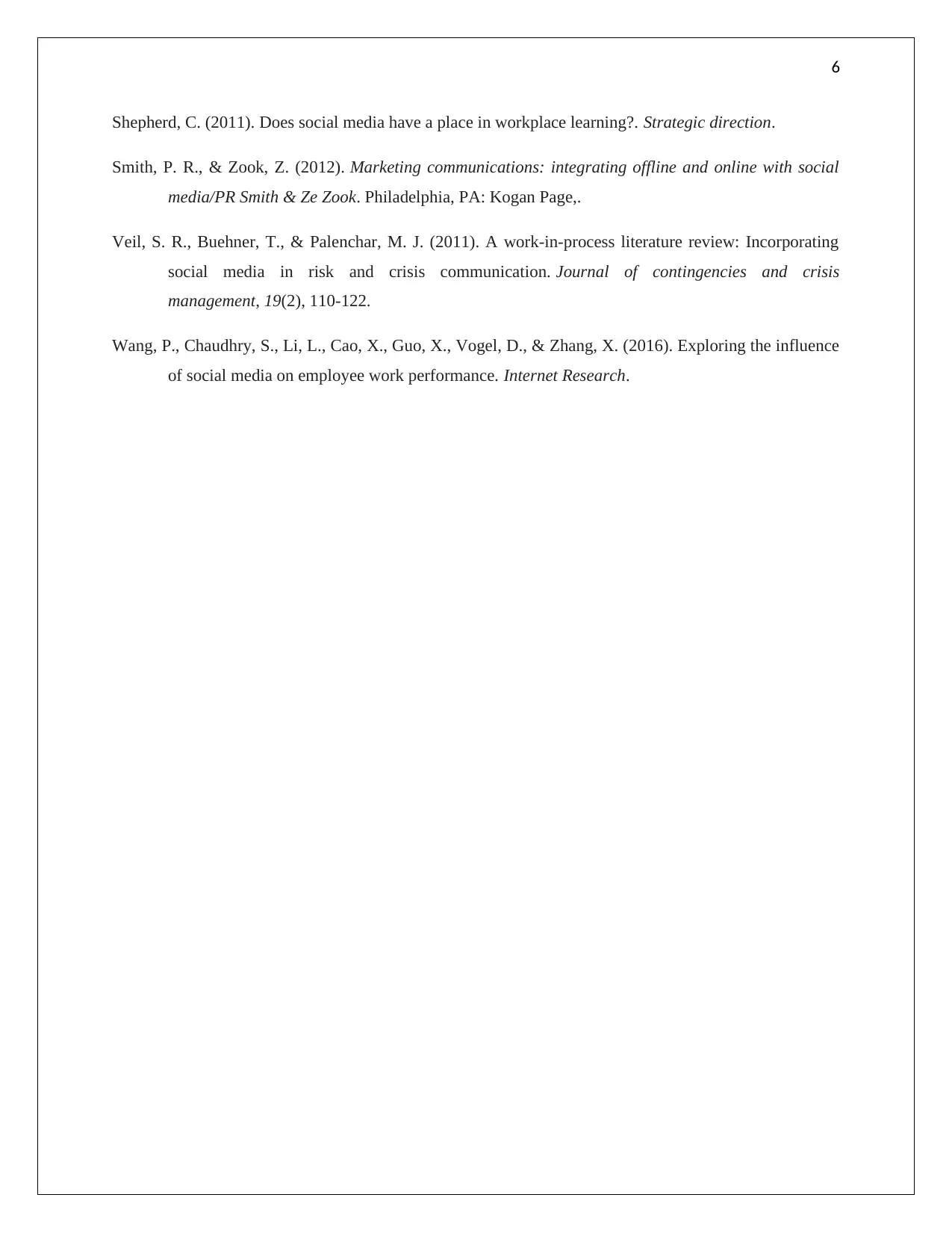
6
Shepherd, C. (2011). Does social media have a place in workplace learning?. Strategic direction.
Smith, P. R., & Zook, Z. (2012). Marketing communications: integrating offline and online with social
media/PR Smith & Ze Zook. Philadelphia, PA: Kogan Page,.
Veil, S. R., Buehner, T., & Palenchar, M. J. (2011). A work‐in‐process literature review: Incorporating
social media in risk and crisis communication. Journal of contingencies and crisis
management, 19(2), 110-122.
Wang, P., Chaudhry, S., Li, L., Cao, X., Guo, X., Vogel, D., & Zhang, X. (2016). Exploring the influence
of social media on employee work performance. Internet Research.
Shepherd, C. (2011). Does social media have a place in workplace learning?. Strategic direction.
Smith, P. R., & Zook, Z. (2012). Marketing communications: integrating offline and online with social
media/PR Smith & Ze Zook. Philadelphia, PA: Kogan Page,.
Veil, S. R., Buehner, T., & Palenchar, M. J. (2011). A work‐in‐process literature review: Incorporating
social media in risk and crisis communication. Journal of contingencies and crisis
management, 19(2), 110-122.
Wang, P., Chaudhry, S., Li, L., Cao, X., Guo, X., Vogel, D., & Zhang, X. (2016). Exploring the influence
of social media on employee work performance. Internet Research.
1 out of 7
Related Documents
Your All-in-One AI-Powered Toolkit for Academic Success.
+13062052269
info@desklib.com
Available 24*7 on WhatsApp / Email
![[object Object]](/_next/static/media/star-bottom.7253800d.svg)
Unlock your academic potential
Copyright © 2020–2025 A2Z Services. All Rights Reserved. Developed and managed by ZUCOL.





